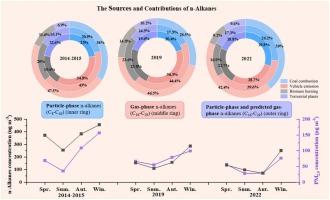Characteristic trends and source shifts of n-alkanes in a multi-year study: Insights from gas-particle partitioning in a central Chinese city
IF 12.2
1区 环境科学与生态学
Q1 ENGINEERING, ENVIRONMENTAL
引用次数: 0
Abstract
Understanding the carbon distribution and source shifts of n-alkanes, which have considerable environmental and public health implications, is vital for assessing the long-term atmospheric behaviour of organic compounds. Here, we combined seasonal data of PM2.5 bounded n-alkanes (C8-C40) collected in a Chinese city across three time periods (2014–2015, 2019, 2022) to investigate their characteristics and source proportions over time. The annual average concentration of particulate n-alkanes in 2022 was 118 ng m⁻³ , showing a 41 % decline from 2019 and a 50 % reduction from 2014 to 2015. Diagnostic ratio analysis (carbon preference index and plant wax ratio) revealed that anthropogenic sources dominated in all three periods. Positive Matrix Factorisation (PMF) model of PM2.5 bounded n-alkanes identified a shift from coal combustion to motor vehicle emissions as the primary source, while contributions from plant waxes increased in 2022 (22.6 %) compared to 2014–2015 (18.8 %) and 2019 (19.6 %). A comparative analysis of the source of intermediate and semi-volatile n-alkanes (C16-C29, including measured particle-phase and predicted gas-phase) against particle-phase n-alkanes (C16-C29) demonstrated notable discrepancies, highlighting the significant role of gas-particle partitioning in source attribution. These insights deepen the understanding of long-term n-alkane trends and are critical for designing effective air pollution control strategies.

求助全文
约1分钟内获得全文
求助全文
来源期刊

Journal of Hazardous Materials
工程技术-工程:环境
CiteScore
25.40
自引率
5.90%
发文量
3059
审稿时长
58 days
期刊介绍:
The Journal of Hazardous Materials serves as a global platform for promoting cutting-edge research in the field of Environmental Science and Engineering. Our publication features a wide range of articles, including full-length research papers, review articles, and perspectives, with the aim of enhancing our understanding of the dangers and risks associated with various materials concerning public health and the environment. It is important to note that the term "environmental contaminants" refers specifically to substances that pose hazardous effects through contamination, while excluding those that do not have such impacts on the environment or human health. Moreover, we emphasize the distinction between wastes and hazardous materials in order to provide further clarity on the scope of the journal. We have a keen interest in exploring specific compounds and microbial agents that have adverse effects on the environment.
 求助内容:
求助内容: 应助结果提醒方式:
应助结果提醒方式:


